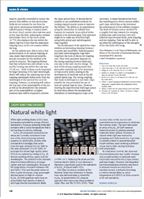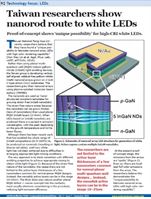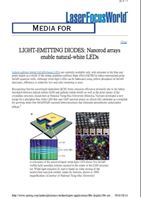- Research
- III-Nitrides
III-Nitrides
Nitride
Titanium nitride
Titanium Nitride Epitaxial Films as a Plasmonic Material Platform: Alternative to Gold
ACS Photonics 6, 8, 1848–1854 (2019)
Wan-Ping Guo, Ragini Mishra, Chang-Wei Cheng, Bao-Hsien Wu, Lih-Juann Chen, Minn-Tsong Lin, and Shangjr Gwo*
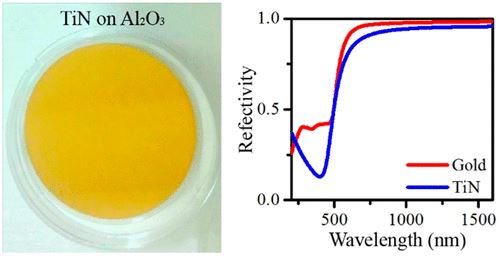
Titanium nitride (TiN) is an interesting refractory metallic compound which could replace gold as an alternative plasmonic material, especially for high temperature and semiconductor compatible applications. However, reported plasmonic properties of TiN films are so far limited by conventional growth techniques, such as reactive sputtering. In this work, we adopt the nitrogen-plasma-assisted molecular-beam epitaxy (MBE) to grow single-crystalline, stoichiometric TiN films on sapphire substrates. The properties of as-grown TiN epitaxial films have been fully characterized by X-ray diffraction (XRD), transmission electron microscopy (TEM), spectroscopic ellipsometry (SE), and surface plasmon polariton (SPP) interferometry. We have confirmed that MBE-grown TiN films exhibit excellent plasmonic properties to replace gold in the visible and near-infrared spectral regions. Measuring the real and imaginary parts of dielectric function by SE, it is also found that TiN is better than gold in the short-wavelength range (<500 nm), where gold suffers from strong loss due to interband transition. Contrary to the recent theoretical prediction that air is not able to stabilize SPP modes at the TiN surface, our surface plasmon interferometry data clearly show the presence of propagating SPP modes at the TiN/air interface. To demonstrate the unique plasmonic properties of MBE-grown stoichiometric TiN, we have fabricated TiN metasurfaces for the visible-spectrum applications.
III-Nitrides
Single InGaN nanodisk light emitting diodes as full-color subwavelength light sources
Appl. Phys. Lett. 98, 233101 (2011)
Yu-Jung Lu (呂宥蓉), Hon-Way Lin (林弘偉), Hung-Ying Chen (陳虹穎), Yu-Chen Yang (楊右丞), and Shangjr Gwo (果尚志)
Subwavelength electroluminescent sources with spatial, spectral, and polarization controlling capabilities are critical elements for optical imaging and lithography beyond the diffraction limit. Here, we show that the electroluminescence from single, strain-free InGaN nanodisks embedded in self-assembled GaN p-n nanorods can span the entire visible spectrum with a large linear polarization ratio ( ∼ 0.85). Furthermore, this unique nanodisk-in-nanorod geometry enables the realization of the ultrasmall footprint light-emitting diodes (LEDs) to be used as subwavelength light sources. Using these nano-LEDs, we are able to demonstrate near-field, subwavelength photolithography by controlling the exposure time and light intensity from single InGaN nanodisks at chosen wavelengths.
Highlights in
PHYSORG, June 17, 2011

Is electron accumulation universal at InN polar surfaces?
Appl. Phys. Lett. 98, 052101 (2011)
Cheng-Tai Kuo (郭承泰), Shih-Chieh Lin (林詩傑), Kai-Kuen Chang (張凱焜), Hung-Wei Shiu (許紘瑋), Lo-Yueh Chang (張羅嶽), Chia-Hao Chen (陳家浩), Shu-Jung Tang (唐述中), and Shangjr Gwo (果尚志)

Recent experiments indicate the universality of electron accumulation and downward surface band bending at as-grown InN surfaces with polar or nonpolar orientations. Here, we demonstrate the possibility to prepare flatband InN surfaces. We have also measured the surface stoichiometry of InN surfaces by using core-level photoelectron spectroscopy. The flatband InN surface is stoichiometric and free of In adlayer. It implies that the removal of In adlayer at the InN surface leads to the absence of downward surface band bending. On the other hand, the stoichiometric InN surface still exhibits surface band bending due to the noncentrosymmetry in the wurtzite structure.
InGaN/GaN nanorod array white light-emitting diode
Appl. Phys. Lett. 97, 073101 (2010)
Hon-Way Lin (林弘偉), Yu-Jung Lu (呂宥蓉), Hung-Ying Chen (陳虹穎), Hong-Mao Lee (李弘
貿), and Shangjr Gwo (果尚志)
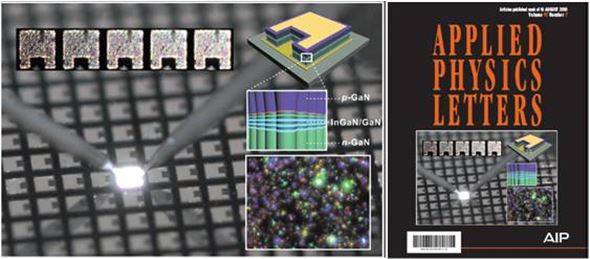
Conventional InGaN/GaN light-emitting diodes based on planar quantum well structures do not allow for efficient long-wavelength operation beyond the blue region due to a strong quantum confined Stark effect in lattice-mismatched polar InGaN quantum wells. Here we overcome the limitation by using self-assembled GaN nanorod arrays as strain-free growth templates for thick InGaN nanodisks. In combination with enhanced carrier localization and high crystalline quality, this approach allows us to realize full-color InGaN nanodisk emitters. By tailoring the numbers, positions, and thicknesses of polychromatic nanodisk ensembles embedded vertically in the GaN nanorod p-n junction, we are able to demonstrate natural white (color temperature ∼ 6000 K) electroluminescence from InGaN/GaN nanorod arrays.
Highlights in
Nature Photonics 4, 738 Nature Nanotechnology 5, 695 Semiconductor Today 5, 92 Laser Focus World 46
November 2010 Octobor 2010 September 2010 October 2010
